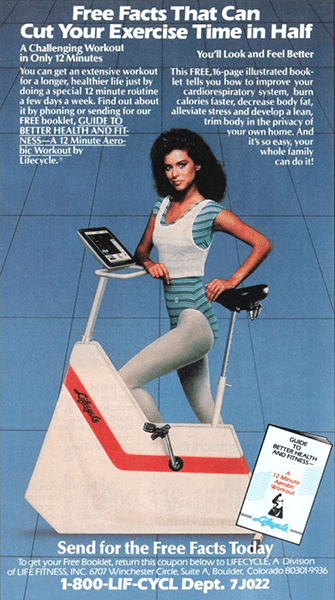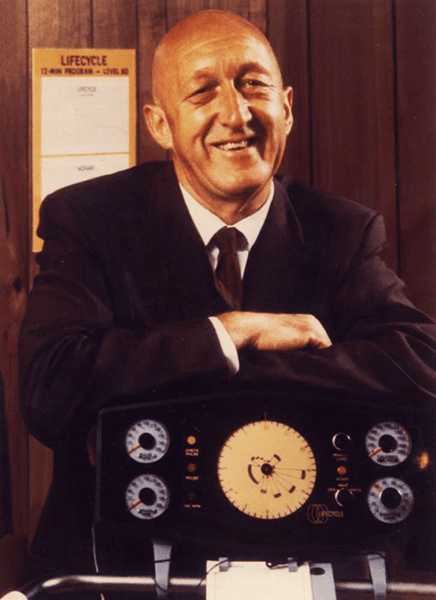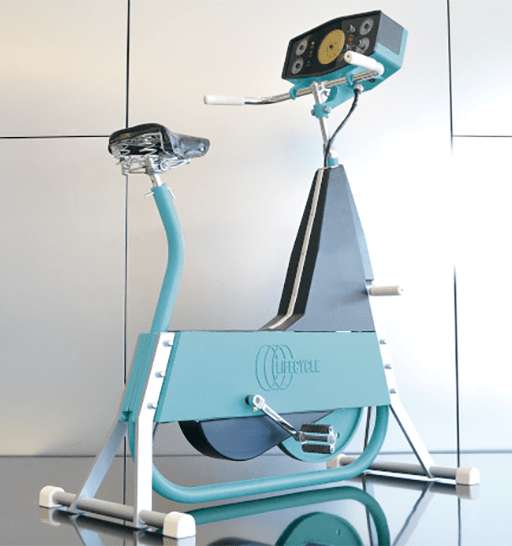The forgotten father of modern fitness: Shoddy Goods 010
7
Like it or not, this is Jason Toon with yet another Shoddy Goods, the newsletter from Meh about the stuff people make, buy, and sell. Fitness and I have an on-again, off-again relationship: as soon as I get on an exercise bike, I want to get off again. When I stumbled across an old ad for a funny-looking thing called a LifeCycle, I wondered if there might be a story in it…
Online marketplaces are littered with the skeletal remains of countless neglected dreams. I’m talking, of course, about exercise bikes. Every few years, a new trademarked stationary cycling craze sweeps the land: Peloton a few years ago, SoulCycle a little while before that, Spinning back there somewhere. Each brings their own generation of tech frills and cultural cache. Each briefly spikes enthusiasm and sales among legions of converts who quickly remember that they kind of hate it. The bikes that go nowhere are so often the fitness resolution that goes nowhere.
Whose fault is this? Or, to accentuate the positive, who gets the credit for helping all those people who do stick with their pedal-powered regimens?
Nobody knows who first had the idea for a stationary cycle: they date way back to the 18th century. But we do know who first put sensors on one of those bikes to tell you how fast you’re going and how many calories you’ve burned. Who first came up with programmed routines for specific fitness goals. Who was the originator not only of the trendy techno-bikes but the very concept of workout equipment that also measures your workout: the backbone of the modern gym.
He was a chemist born in Idaho in 1915. By the time he invented his high-tech LifeCycle, Keene Paul Dimick had already done two careers’ worth of high-profile, innovative things. And those things tell a story about America in the mid-20th century.

Gee, I wonder what decade this is from.
The strawberry code
Near as I can tell online, Dimick first pops up in the public eye in the 1950s as a chemist at the U.S. Department of Agriculture in Albany, California. The USDA assigned Dimick the job of investigating the volatile flavour compounds of a major local crop, strawberries. Chemically speaking, what makes strawberries taste the way they do? He wasn’t getting anywhere until he read an article about a new process called gas chromatography.
I’m getting dangerously out of my depth here, but essentially, a gas chromatograph takes a sample of whatever you’re testing, vaporizes it, and mixes it with an inert gas that separates the various chemical compounds in the sample so they can be identified individually. (Please correct me in the forum thread, but I think that’s the general idea.)
Dimick thought the process sounded promising not only for his project but for the food industry in general. Remember, this was the 1950s, the age of “better living through chemistry” and an exploding population. Big food companies were chasing how to cheaply mimic natural flavors without the unpredictable and costly messiness of nature. If you could figure out exactly what synthetic chemicals add up to strawberry flavoring, candy makers would never need to touch another real strawberry.
Unfortunately, gas chromatographs were impossible to get. The few companies producing them were tiny, or out of business, or on the other side of the world. So Dimick found some plans and built his own. He presented his results in 1956: he’d cracked the strawberry code.
Then he went into his garage with his brother-in-law and they built five more gas chromatographs. They called their model the Aerograph and all five sold immediately to Dimick’s peers in the food industry. It wasn’t long before Dimick said goodbye to the USDA. He was in the chromatograph business now.
And business was good. By 1962 they were selling $3 million worth of Aerographs a year. By 1965, that was $8.5 million. The following year, the company was acquired for $12 million. The food industry’s craving for cheap artificial flavors had made this scientist so rich, he never had to work again. Keene Dimick had certainly found better living through chemistry.
Days of wine and dumbbells
Even though he was past 50 by then, Dimick was evidently not immune to the bacchanalian bohemianism wafting from hippie meccas like nearby San Francisco. He turned his attention to his 65-acre vineyard in Napa Valley. Was it a reaction to all those long days closed up in stuffy laboratories? After a career concocting chemical caricatures of real flavors, did Dimick long to dig his fingers into the rich brown earth and summon its natural bounty?
Well, maybe. What we do know is that this restless polymath somehow hooked up with another technically-minded go-getter transforming an industry. Robert Mondavi founded his namesake winery the same year that Dimick sold his chromatograph company. Among other innovations, Mondavi was the driving force behind New World wines being labeled by varietal rather than location.
Dimick grew one varietal of grapes that was in high demand by Mondavi, and would soon become the quintessential California white: Chardonnay. The two made a deal, and Dimick’s grapes were thus part of the wine that, more than any other, established the California wine industry commercially. Once again, the chemist from Idaho found himself right at the crest of a wave in America’s changing culture.
But it wasn’t all hedonism and self-indulgence. Dimick was an early enthusiast of another burgeoning trend of the coming Me Decade: physical fitness.

They called me MAD at the Institute!
Now that fitness is a megabillion-dollar industry towered over by some of the most inescapable brands on Earth, it’s almost impossible to conceive of how marginal it was through the 1960s. In movies and TV shows, pumped-up fitness freaks were objects of ridicule, or at least arm’s-length fascination: sure, they were healthier, but also, just… odd.
Mass-market fitness centers were almost nonexistent. Aside from a few eccentric musclemen heaving dumbbells in dusty boxing gyms, exercise was basically something that kids did in school. The average suburbanite would no more run on a treadmill than they would give up smoking or read Das Kapital. Of course, a lot more of the population had jobs where they got plenty of physical exercise. And everybody ate a lot less sugar than today. The concept of consciously working out grew in direct proportion to its necessity.
Anyway, in semi-retirement, Keene Dimick spent a lot of time on his exercise bike. But his scientific brain wasn’t satisfied with the inexact science of analog workouts. Something was missing.
Lifecycle happens
“Mr. Dimick is a scientist and the machine is a scientific wonder,” said the Santa Rosa Press-Democrat on May 22, 1969. “It has different levels of effort, gauges to keep the pace steady and a device that measures your pulse while you are working at it.”
This piece, a small-town local-color blurb, is the earliest mention I can find of the “bicycle-like contrivance” Dimick called the Lifecycle. It says Dimick was just starting up production of the bikes at a plant in nearby Concord. And then…
…nothing much happened. At least not right away. It seems Dimick sold some Lifecycles to universities and other institutions with a specialized interest in measuring fitness data. Some of his business and scientific colleagues bought them. He developed his original designs further to offer more sophisticated measuring capability, and pre-programmed workouts. Dimick’s Lifecycle never quite took off with the public - but crucially, no imitators caught up with the Lifecycle.
So, in 1977, Dimick sold the rights to the Lifecycle to a fitness center owner named Ray Wilson and an entrepreneur named Augie Nieto. By now, commercial gyms were becoming a thing: still small by today’s standards, but they were out there. Nieto sent free Lifecycles to the 50 biggest commercial gyms in America and tirelessly hustled them in person, sure that the leotard-and-legwarmer crowd would discover the brilliance of Dimick’s invention.

The original. Is it just me or is this way cooler looking than anything in any gym today?
- 8 comments, 15 replies
- Comment
Ah. You would be speaking of Jack LaLanne. I remember his show.
@werehatrack I was hoping it will be about Bernarr MacFadden.
@mossygreen My understanding of MacFadden has him as a major proponent of achieving physical conditioning, but not as an inventor of exercise machines nor primarily a promoter of their use. “Physical Culture”, from what I recall, was more about pushing limits in ordinary bodybuilding and athletic regimes, combined with vegetarianism and some other quirks. He ultimately fell far short of “living to be 150” as he had forecast that his approach would allow him to do.
@werehatrack You are correct. Bernarr MacFadden was, in fact, the forgotten father of trashy tabloids, as the publisher of The New York Graphic. I just kind of love him.
@mossygreen @werehatrack
Not Jim Fixx then obviously…
@mossygreen @werehatrack …and fasting for up to a week at a time- don’t forget.
@werehatrack Annnn… Jack LaLanne was a swingandamiss. Strike two for me!
@PhysAssist @werehatrack FASTING AND SPINAL EXERCISES, MY FRIEND.
So, even more geeky, we own a stationary recumbent bike…
@djslack SWMBO has one of those too.
@PhysAssist Same. Really the only time it’s mine is when it needs to be moved.
@djslack
@djslack I want one that’s not stationary, but I should really sell four of the bikes I already have before I acquire that. I have a tandem, a Giant fixie, an Electra Townie, an eBike, a Trek carbon-frame dual-sus MTB that I’ve converted to hybrid, a hardtail hybrid ex-Houston-Police bike, a couple of “I’m not sure why these are here” bikes, a Dahon folder, and a late-80s Trek steel-frame roadie. That’s just too many.
We actually have a Life Cycle, which is quite similar to the one in the advert with some cosmetic differences in the control panel and a square vs round seat-tube.
I bought it from Life Fitness on a 0% interest plan and have beaten the heck out of myself on it in the approximately 35 years I have owned it. I still use it, although not as often as I did in my post-knee replacement rehab process.
We also have a likewise fully-functional Life Stepper, but it hasn’t been used since my knee replacement in 2010- on doctor’s orders.
I will sell it if anyone is interested in purchasing a lightly-used model. Shipping will be your problem.
Amazing…my very first ‘nerd’ job was working in a honeybee research lab, where I learned to run a fancy gas chromatograph instrument.
This was right about the time that Dimick was inventing the LifeCycle…
(and you’re pretty much correct about how they work)
Very interesting article, I’ll probably read them more often now. Who knew?? Thanks for enlightening us!!
Various things in this thread have reminded me of a late-night infomercial from a couple of decades ago that was my favorite infomercial ever, but it has somehow managed to avoid being a youtube sensation or, indeed, possible to find a copy of at all.
It was an infomercial for a juicer, in which a man with giant gandalf-style eyebrows ranted about how pasteurized juice is dead and only freshly squeezed juice is alive, getting increasingly agitated, until at one point in the ad he full-on growled “death… death… DEEAAATH”
At least, that’s how I remember it.
@ravenblack The Juiceman!
/youtube jay kordich the juiceman
@mossygreen I thought from that video that he didn’t look eyebrowy enough to be the right guy, but it looks like he aged into it - here he is looking much eyebrowier.
So yeah, the DEEAAATH scene must have been from one of his later works.
@ravenblack Yeah, I mean, apparently it’s his first infomercial, but did you SEE the eyebrows in the thumbnail photo? They’re load-bearing.
How do I get back issues?
@jjeanot Psst…here’s an archive link we haven’t yet made public:
https://shoddygoods.meh.com/archive
It worked. By 1981, Lifecycle was a sensation, the top-selling fitness device in the world, with a trendy design that screamed EIGHTIES louder than Emmanuel Lewis and Cyndi Lauper playing Space Invaders. Every NFL team had a Lifecycle in the locker room. Video fitness superstar Denise Austin’s personal Lifecycle sold at auction in 2014.
The company Wilson and Nieto created, Life Fitness, enjoyed a solid decade on top of the industry before being overtaken by competitors building on Dimick’s original innovation. It’s still a player, although no longer at its peak. Dimick died in 1990 to no particular fanfare. Nieto was diagnosed with ALS in 2005 and spent the rest of his life raising some $200 million for a cure before he died in 2023.
Lifecycle was the precursor to all those techno-fitness crazes of today - but bigger, because it was the first one. The imitators who followed spawned an entire category of tech-equipped gear that dominates every gym around the world today.
Perhaps unsurprisingly, the fitness industry is not big on reflecting on, or even documenting, its own past. When this history is invoked at all, the much more flamboyant Nieto is usually the one who gets the credit. In a 2005 Tampa Tribune article, an industry insider called Nieto “the Henry Ford of the exercise industry,” adding “without Augie Nieto’s work on Lifecycle… the health club industry clearly wouldn’t be what it’s like today.”
That’s probably true. But it’s at least equally true of Keene Dimick. And that’s what strikes me as poignant about this story. This was basically a nerd from nowhere who put himself at the heart of the synthetic '50s, the cosmopolitan '60s, and the self-improving '70s. But his name is virtually forgotten today, even as people flock in the hundreds of millions to work out on machines he was the first to imagine.
I don’t know if Keene Dimick was a cool guy. But he was an interesting and consequential one. If someone as powerful and privileged as he was can fall into Ozymandias-like obscurity a few decades after his death, what other fascinating stories are in danger of going extinct? Or already have?
Huh, I guess I’d assumed stationary bikes had been around as long as…bikes. But apparently it took awhile before people realized there were other reasons to use one besides just transportation. Do you own an exercise bike? Is it used for anything more than a place to hang mostly-clean laundry? Let us know in this week’s Shoddy Good’s forum chat!
If this Shoddy Goods workout gave you “reader’s high”, keep sweatin’ to these oldies: